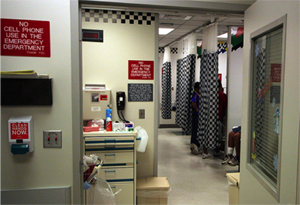
In the information-rich environment of an ER, it’s not practical to expect one person to manage and ongoingly evaluate all information, and indeed, shared and shifting leadership are often noted under these circumstancesi, ii. As part of our evaluation of how interruptions might benefit productivity in places like the ER, we first observed and evaluated interruptions that occur in Stony Brook University Hospital’s Emergency Department. Prior observational studies conducted in other hospital environmentsi, iii, iv had focused on overall rates of interruption to and by physicians, but with no or only broad consideration for the purpose of the interruption.
We followed 16 physicians (5 1st-year residents, 6 senior residents, 5 attendings) for two hours while each was on shift in the SBU Hospital ER. We noted each task the doctor began, suspended, and resumed, and we noted all interruptions experienced during this period.
i. Healey, AN, Savdalis, N, Vincent, CA. Measuring intra-operative interference from distraction and interruption in the operating theatre. Ergonomics: Special Issue On Patient Safety, 2006; 49:589-604.
ii. Smith, RE, Hunt, RR, McVay, JC, McConnell, M. The cost of event-based prospective memory: Salient target events. Journal of Experimental Psychology: Learning, Memory, and Cognition, 2007; 4: 734-746.
iii. Chisholm CD, Dornfeld AM, Nelson DR, Cordell WH. Work interrupted: A comparison of workplace interruptions in emergency departments and primary care offices. Annals of Emergency Medicine, 2001; 38:146-151.
iv. Spencer R, Logan P, Coiera E. Supporting Communication in the Emergency Department, Sydney: Centre for Health Informatics, University of New South Wales; 2002.